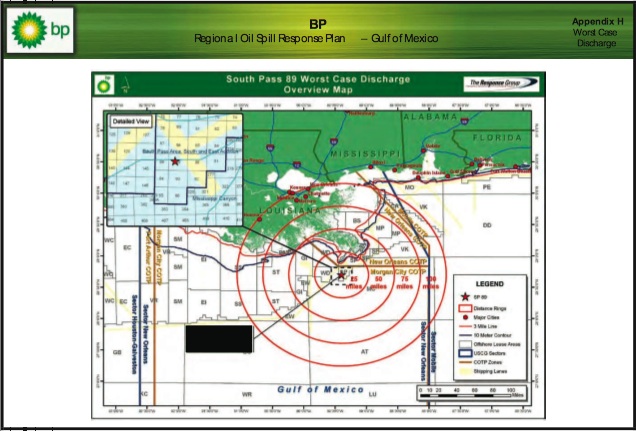
Thanks to an insider, I obtained a copy of the almost 600 page BP Regional Oil Spill Response Plan for the Gulf of Mexico as of June, 2009. Some material has been redacted including the name of the rig, but if it isn't Deepwater Horizon then it's another oil well aimed directly at Plaquemines Parish. These are the three main takeaways from an initial read:
1) In the worst case discharge scenario, an oil leak was expected to come ashore with highest probability in Plaquemines Parish within 30 days (see map above from the Advance Response Plan). This makes it clear that BP could have stored adequate boom there before a rig failure like the Deepwater Horizon, and workers could have been mobilized to apply the boom in the 30 days that the response plan predicted oil would hit our wetlands.
2) Spokespersons were advised never to assure the public that an ecosystem would be back to normal after the worst case scenario, which we are now living through. "No statements shall be made concerning any of the following: promises that property, ecology, or anything else will be restored to normal." Even in BP CEO Tony Hayward's new television commercial his assurance is an ambiguous, "We will make this right," which does not specifically address preserving or restoring America's Wetlands.
3) Corexit oil dispersant toxicity has not been tested on ecosystems, according to the Oil Spill Response Plan. "Ecotoxilogical effects: No toxicity studies have been conducted on this product." (Environmental Defense Fund scientist Richard Denison points out that dispersant maker Nalco's statement in the 2009 Plan is from 2005, and some ecotoxicity data can now be found in other response documents. See his post at http://www.edf.org/chemandnano).
The question and answer section discusses the choice of a dispersant with: "Have environmental tradeoffs of dispersant use indicated that use should be considered? Note: This is one of the more difficult questions" and "Has the overflight to assure that endangered species are not in the application area been conducted?" Brown pelicans and sea turtles would have been the answer to the latter.
When it comes to Corexit, it is allowed in the Green Zone, not in the Red Zone without a waiver, and the Yellow Zone is a maybe. Yellow "includes any waters designated as marine reserves, National Marine Sanctuaries, National or State Wildlife Refugees or proposed or designated critical habitats; the waters are within three miles of a shoreline and/or fall under state jurisdiction; the waters are less than ten meters deep; and the waters are in mangrove or coastal wetland ecosystems or directly over coral reefs which are less than ten meters of water. Coastal wetlands include submerged algal and sea grass beds."
President Barack Obama is in Louisiana today, so these findings bear repeating: BP knew in all probability where a Gulf of Mexico oil leak would go; the company knows it is pouring millions of gallons of chemicals untested for ecotoxicity near endangered wetlands; and BP knew it could not assure us that our environment will ever be back to normal. America deserves an immediate, comprehensive response funded by BP and administered by the government to clean, protect and restore our environment because it will be under chemical assault for months.
Even if the coast is never back to normal, we must make sure that it comes back. And if we can't do it for this generation, then we need to make it happen for the next one.
LINK: http://www.neworleans.com/images/media/BP_Regional_OSRP_Redactedv2.pdf (It's 29 mg so make sure you have the space to download).
